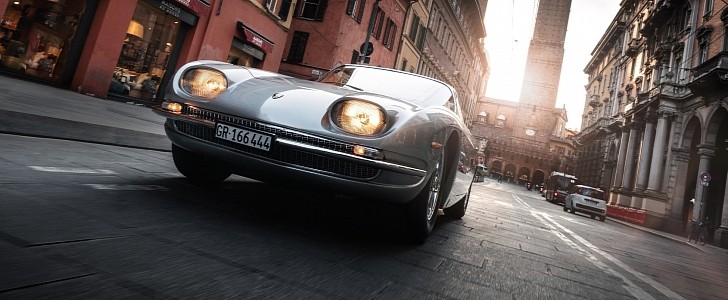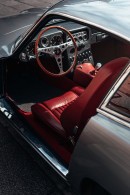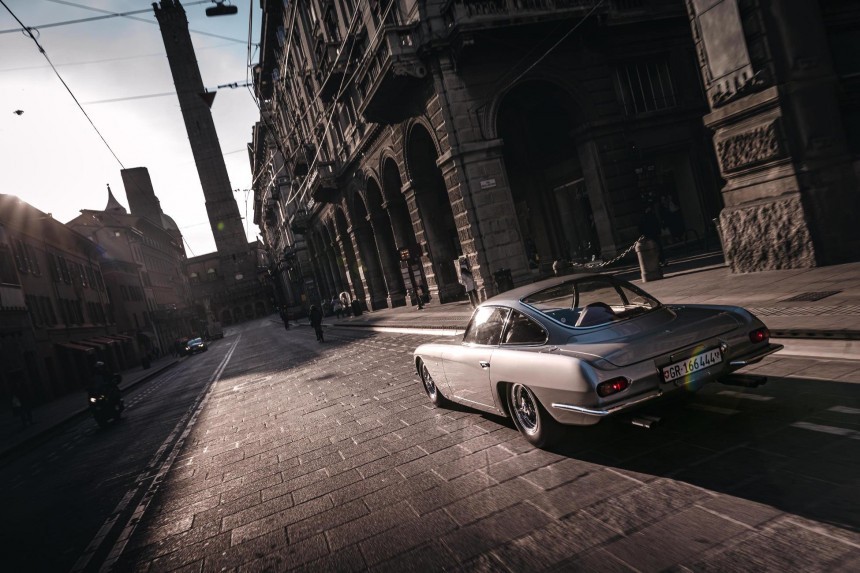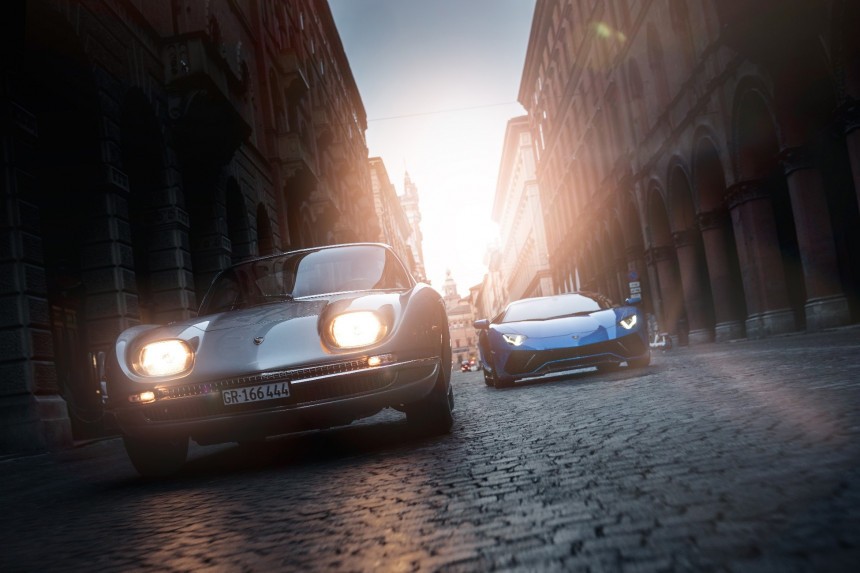We all know the Ferruccio vs. Enzo quarrel. A wealthy industrialist buys a handful of Ferraris equipped with a clutch that goes kaput way too easily, the founder of the world’s most revered automaker tells his affluent customer that he’s a farm boy that shouldn’t complain, and that’s how the tractor-making businessman was provoked into assembling a team of top-notch engineers to beat Ferrari at his own game, fair and square.
The gentleman who stands out above everyone else is Giotto Bizzarrini, the guy who developed the chassis of the Alfa Romeo Giulietta. Before he founded his very own auto-making outfit, Bizzarrini made a name for himself by working on the Ferrari 250 GTO, a blue-chip collectible that’s currently going for plenty of money, regardless of condition and history.
The Italian engineer developed the V12 engine that Lamborghini used from 1963 through 2010, a masterpiece that went from 3.5 liters to 6.5 liters during this period. Franco Scaglione and Giorgio Prevedi were tasked with the design. Finally, the 350 GTV wouldn’t have been possible without Giampaolo Dallara and Paolo Stanzani. Presented at the 1963 Turin Auto Show, the 350 GTV previewed Lambo’s first production car, the GT 350.
Ferruccio wasn’t really pleased by a number of details, including the pop-up headlights and high-strung engine, which is why the 350 GTV and 350 GT are very different animals. For starters, Milan’s Carrozzeria Touring was hired to refine the body shell into something more suitable for series production. For example, the Italian coachbuilder switched from a mix of aluminum and steel panels to aluminum everything. Some things, however, did carry over, including a rather quirky 2+1 seating layout for early cars.
The GTV had been painstakingly assembled in Ferruccio’s tractor factory, but the GT was built at the Sant’Agata Bolognese assembly plant where Automobili Lamborghini is based to this day. The Lamborghini 350 GT premiered at the 1964 Geneva Motor Show in the guise of chassis #0101.
Instead of the GTV’s square tubes, the bite-the-back-of-your-hand beautiful GT features round tubes for the spaceframe chassis. Gifted with double wishbones on every corner during a time when Ferrari used live rear axles, the raging bull further boasts 100 additional millimeters in wheelbase compared to its forerunner. Coil springs, telescopic shock absorbers, anti-roll bars, disc brakes, and wire wheels are featured, along with rear fender-mounted 40L fuel tanks. The GTV, on the other hand, used a single tank.
The posh-looking Borranis were initially mounted with Pirelli Cinturato tires. Standard equipment was exceptionally plentiful for that era, which is why optional extras were very few and far between. Bumper overriders open the list, along with different axle ratios and instrumentation. Also worthy of note, the GT also offered two windshield wipers instead of one.
Tipping the scales at 1,290 kilograms (2,844 pounds) compared to 1,050 kilograms (2,315 pounds) for the GTV, the GT was exclusively offered with a five-speed manual transmission supplied by ZF. Ferraris used four-speed units back then. Adding insult to injury, the 3.5-liter V12 features a DOHC valvetrain, while Ferrari couldn’t do better than SOHC in the 250 series. The Colombo V12, named this way after Gioacchino Colombo, gained dual overhead camshafts at the 1966 Paris Motor Show with the introduction of the 275 GTB/4. Indeed, the four in 275 GTB/4 stands for four camshafts.
The Bizzarrini V12 in the 350 GT is an all-alloy lump that was modified in a few notable ways for street use. Gone were the original downdraught carburetors in favor of sidedraughts from Weber, the dry-sump lubrication system was replaced with a wet-sump, the compression ratio went from 11.0:1 to 9.5:1, and the cooling system’s capacity went up by a few liters.
Internally referred to as L350, this engine uses Marelli-supplied coils and distributors, packs 280 horsepower, and cranks out 240 pound-feet (325 Nm) of torque. As opposed to chassis #0101, which had six exhaust tips, the production-spec boasts four. It premiered at the 1964 Paris Motor Show.
A convertible by the name of 350 GTS was designed by Touring at Ferruccio’s request, but only two examples were produced: #0325 from the 1965 Paris Motor Show and #0328, which sweetens the deal with a hard top. Two more special cars were produced: 3500 GTZ #0310 and 3500 GTZ #0320, bodied by Carrozzeria Zagato of Milan with berlinetta body shells.
In the last months of production, Touring switched from aluminum to steel because it was cheaper. Only 24 such cars were delivered. A little more than 100 units of the 350 GT were manufactured, all of them in left-hand drive.
Come March 1966, the Italian automaker introduced the 400 GT, the last hurrah of the GT series. Just over 200 units were produced through 1968, the year the oft-overlooked Islero took over. Bodied in steel panels, the heavier 400 GT features a 3.9-liter version of the Bizzarrini V12, a powerplant that made its debut in 1966 in the jaw-dropping Miura P400.
The Italian engineer developed the V12 engine that Lamborghini used from 1963 through 2010, a masterpiece that went from 3.5 liters to 6.5 liters during this period. Franco Scaglione and Giorgio Prevedi were tasked with the design. Finally, the 350 GTV wouldn’t have been possible without Giampaolo Dallara and Paolo Stanzani. Presented at the 1963 Turin Auto Show, the 350 GTV previewed Lambo’s first production car, the GT 350.
Ferruccio wasn’t really pleased by a number of details, including the pop-up headlights and high-strung engine, which is why the 350 GTV and 350 GT are very different animals. For starters, Milan’s Carrozzeria Touring was hired to refine the body shell into something more suitable for series production. For example, the Italian coachbuilder switched from a mix of aluminum and steel panels to aluminum everything. Some things, however, did carry over, including a rather quirky 2+1 seating layout for early cars.
The GTV had been painstakingly assembled in Ferruccio’s tractor factory, but the GT was built at the Sant’Agata Bolognese assembly plant where Automobili Lamborghini is based to this day. The Lamborghini 350 GT premiered at the 1964 Geneva Motor Show in the guise of chassis #0101.
The posh-looking Borranis were initially mounted with Pirelli Cinturato tires. Standard equipment was exceptionally plentiful for that era, which is why optional extras were very few and far between. Bumper overriders open the list, along with different axle ratios and instrumentation. Also worthy of note, the GT also offered two windshield wipers instead of one.
Tipping the scales at 1,290 kilograms (2,844 pounds) compared to 1,050 kilograms (2,315 pounds) for the GTV, the GT was exclusively offered with a five-speed manual transmission supplied by ZF. Ferraris used four-speed units back then. Adding insult to injury, the 3.5-liter V12 features a DOHC valvetrain, while Ferrari couldn’t do better than SOHC in the 250 series. The Colombo V12, named this way after Gioacchino Colombo, gained dual overhead camshafts at the 1966 Paris Motor Show with the introduction of the 275 GTB/4. Indeed, the four in 275 GTB/4 stands for four camshafts.
The Bizzarrini V12 in the 350 GT is an all-alloy lump that was modified in a few notable ways for street use. Gone were the original downdraught carburetors in favor of sidedraughts from Weber, the dry-sump lubrication system was replaced with a wet-sump, the compression ratio went from 11.0:1 to 9.5:1, and the cooling system’s capacity went up by a few liters.
A convertible by the name of 350 GTS was designed by Touring at Ferruccio’s request, but only two examples were produced: #0325 from the 1965 Paris Motor Show and #0328, which sweetens the deal with a hard top. Two more special cars were produced: 3500 GTZ #0310 and 3500 GTZ #0320, bodied by Carrozzeria Zagato of Milan with berlinetta body shells.
In the last months of production, Touring switched from aluminum to steel because it was cheaper. Only 24 such cars were delivered. A little more than 100 units of the 350 GT were manufactured, all of them in left-hand drive.
Come March 1966, the Italian automaker introduced the 400 GT, the last hurrah of the GT series. Just over 200 units were produced through 1968, the year the oft-overlooked Islero took over. Bodied in steel panels, the heavier 400 GT features a 3.9-liter version of the Bizzarrini V12, a powerplant that made its debut in 1966 in the jaw-dropping Miura P400.







































